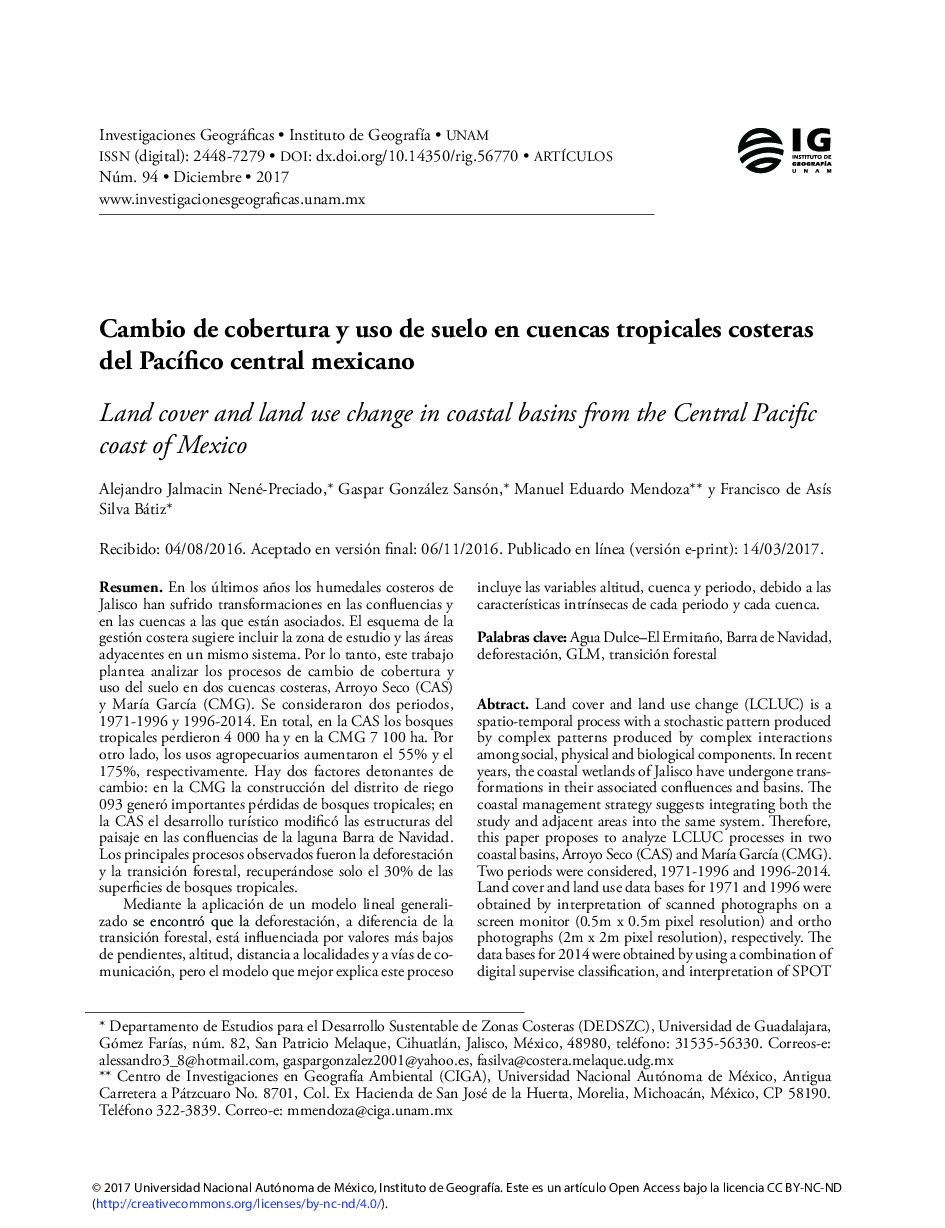| کد مقاله | کد نشریه | سال انتشار | مقاله انگلیسی | نسخه تمام متن |
|---|---|---|---|---|
| 7473947 | 1485174 | 2017 | 18 صفحه PDF | دانلود رایگان |
عنوان انگلیسی مقاله ISI
Cambio de cobertura y uso de suelo en cuencas tropicales costeras del PacÃfico central mexicano
دانلود مقاله + سفارش ترجمه
دانلود مقاله ISI انگلیسی
رایگان برای ایرانیان
موضوعات مرتبط
علوم انسانی و اجتماعی
علوم اجتماعی
جغرافیا، برنامه ریزی و توسعه
پیش نمایش صفحه اول مقاله

چکیده انگلیسی
Land cover and land use change (LCLUC) is a spatio-temporal process with a stochastic pattern produced by complex patterns produced by complex interactions among social, physical and biological components. In recent years, the coastal wetlands of Jalisco have undergone transformations in their associated confluences and basins. The coastal management strategy suggests integrating both the study and adjacent areas into the same system. Therefore, this paper proposes to analyze LCLUC processes in two coastal basins, Arroyo Seco (CAS) and MarÃa GarcÃa (CMG). Two periods were considered, 1971-1996 and 1996-2014. Land cover and land use data bases for 1971 and 1996 were obtained by interpretation of scanned photographs on a screen monitor (0.5m x 0.5m pixel resolution) and ortho photographs (2m x 2m pixel resolution), respectively. The data bases for 2014 were obtained by using a combination of digital supervise classification, and interpretation of SPOT fused imagines on a screen monitor (2.5m x 2.5m pixel resolution). In all cases, images were displayed on a monitor screen at a 1:10,000 scale. The data bases were generated according to FOA approach. The overall confidence level of the interpretation of the 2014 land cover and land use (LCLU) maps was 93% for CAS and 92% for CMG. During the study period (43 years), CAS lost 4,000 ha of tropical forests and CMG 7,100 ha. Agricultural use increased by 55% for CAS and 175% for CMG, representing the most important change. In synthesis, the main processes observed are deforestation and forest transition, depicting a recovery of 30% of deforested surface. The processes of deforestation and forest transition represent about 95% of all changes. A Generalized Linear Model (GLM) was used to find the relationship of deforestation and forests transition processes with some independent variables. Deforestation or forest transition were used as response variables at of each point while altitude, slope, soil type and distance to roads and localities were used as explained variables. The data base was built from a network of points every 500 meters. Two factors were also considered: basin (with two levels, CAS and CMG) and period (with two levels, P1 and P2). The data were adjusted by a GLM considering the distribution of the response variable as binomial and as a function of link the logit function. The tropical dry forest is one of the most affected land covers in the coast of Jalisco due to agricultural expansion even though there are land use and watershed management plans established in the area. There are two ”external” factors that stimulated major changes, on the one hand, the construction of the irrigation district in the CMG, which promoted the loss of large areas of tropical dry forests and hydrophilic and halophilic vegetation. On the other hand, in the CAS the establishment of a touristic development has caused great modifications in the landscape at the confluences of the Barra de Navidad Lagoon. By applying a Generalized Linear Model, we found that deforestation, unlike forest transition, is influenced by lower values of: slope, altitude, distance to human settlements and roads, but the model that best explains these processes, includes such variables as altitude, basin and period, due to the intrinsic characteristics of each period and basins. The model chosen gives statistical support to the trends observed in the analysis, but part of the observed variability is not explained by the model.
ناشر
Database: Elsevier - ScienceDirect (ساینس دایرکت)
Journal: Investigaciones Geográficas, BoletÃn del Instituto de GeografÃa - Volume 2017, Issue 94, December 2017, Pages 64-81
Journal: Investigaciones Geográficas, BoletÃn del Instituto de GeografÃa - Volume 2017, Issue 94, December 2017, Pages 64-81
نویسندگان
Alejandro Jalmacin Nené-Preciado, Gaspar González Sansón, Manuel Eduardo Mendoza, Francisco de AsÃs Silva Bátiz,